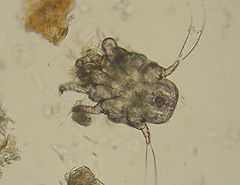Ear mite
| Ear mite | |
|---|---|
 |
|
| Otodectes cynotis | |
| Scientific classification | |
| Kingdom: | Animalia |
| Phylum: | Arthropoda |
| Subphylum: | Chelicerata |
| Class: | Arachnida |
| Subclass: | Acarina |
| Superorder: | Acariformes |
| Order: | Astigmata |
| (unranked): | Psoroptidia |
| Superfamily: | Psoroptidae (partim) |
| Genera | |
Several, including:
Otodectes
Psoroptes
Ear mites are mites that live in the ears of animals and humans. The most commonly seen species in veterinary medicine is Otodectes cynotis (Gk. oto=ear, dectes=biter, cynotis=of the dog). This species, despite its name, is also responsible for 90% of ear mite infections in cats.
In veterinary practice, ear mite infections in dogs and cats may present as a disease that causes intense itching in one or both ears, which in turn triggers scratching at the affected ear. An unusually dark colored ear wax (cerumen) may also be produced. Cats, as well as dogs with erect ears that have control over ear direction, may be seen with one or both ear pinnas held at an odd or flattened angle.
The most common lesion associated with ear mites is an open or crusted ("scabbed") skin wound at the back or base of the ear, caused by abrasion of the skin by hind limb claws, as the ear has been scratched in an attempt to relieve the itching. This lesion often becomes secondarily infected and crusted from ordinary skin bacteria, so that the common presentation of ear mites is such a wound appearing on the back or base of one or both ears. This is accompanied by the Pinna-Pedal-Reflex that appears as reflex scratching motions of the hind limb when the ear is manipulated (this test is positive as well in other mite infections of the outside and rim of the ear pinnas in mange). When the ear mite infection is treated, such wounds resolve spontaneously, and this resolution may be speeded with application of topical antibiotics.
The most common ear mite (as well as mange mite) treatments currently use the antiparasitics ivermectin and selamectin, usually as topical preparations. Ivermectin is available as a direct water-based liquid that is squeezed into the ear canal and massaged at the base of the ear to distribute the medication. Selamectin is available as a once-a-month preparation that can be applied to the animal's skin, which prevents mite infestation over that time.
Ear mites spread rapidly, and can be tansmitted from even brief physical contact with other animals. In pets, ear mites most commonly affect cats, ferrets, and to a lesser extent dogs. Humans can rarely be infected with ear mites. Infected animals have a large amount of crumbly dark brown material in their ears. On close inspection, tiny white mites can be seen in the debris. Ear mites do not burrow as some mites do, but live within the ear canal.
...
Wikipedia
